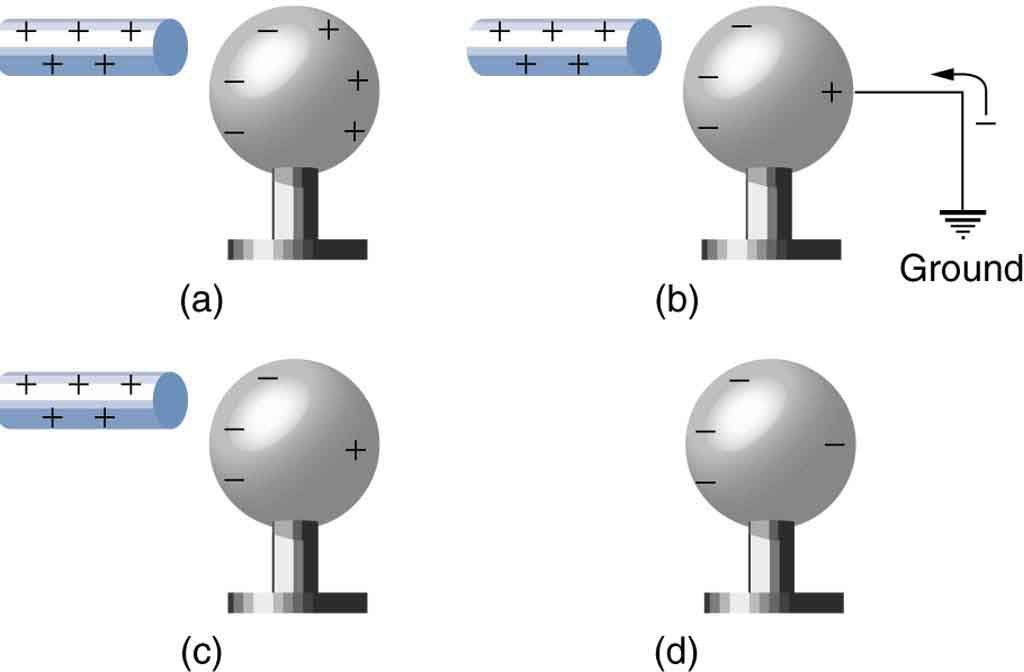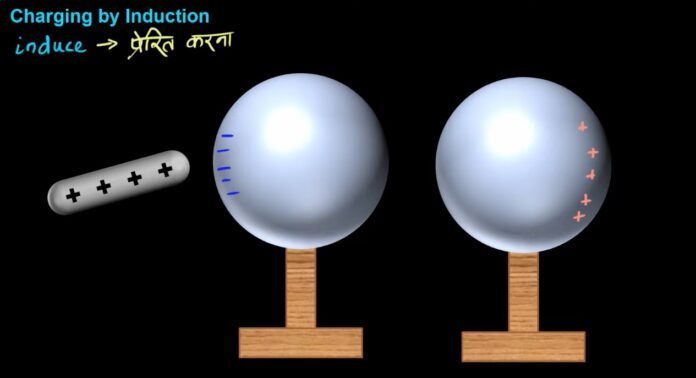Friction charging is a very common method of charging an object. However, it is not the only process by which objects become charged. Charging by induction is a process of transferring electric charge from one object to another by means of the electric field. This is achieved without direct contact between the objects. This phenomenon is commonly used in modern-day technology, such as in the charging of electronic devices wirelessly. In this article, we will explore the science behind charging by induction and its practical applications.
Introduction:
To understand charging by induction, we must first understand the concept of electric charge and electric fields. Electric charge is a fundamental property of matter that gives rise to electromagnetic interactions. Objects with the same charge repel each other, while objects with opposite charges attract each other.
An electric field is a region in space around a charged object where the electric force is exerted on other charged objects. Electric fields can be visualized as lines of force that radiate out from a charged object.
When a charged object is brought close to another object, the electric field of the charged object can induce a separation of charges in the other object. This is known as polarization. If the second object is conductive, the induced charge can flow through the object and create a net charge on its surface.
This process of polarization and charge separation is the basis of charging by induction. To charge an object by induction, a charged object is brought close to the object to be charged. The electric field of the charged object induces a separation of charges in the object to be charged, creating a net charge on its surface.
Charging two-sphere system by using a positively charged object:
Two spheres are placed next to each other (see Figure a. below) to form a two-sphere system. Since they are made of metal (conductors), electrons can move freely between the spheres. From sphere A to sphere B and vice versa. When a glass rod becomes positively charged (perhaps rubbed with animal fur) and brought close to the sphere, the electrons in the two-sphere system are guided toward the rod. This is simply the principle that unlike charges attract each other. Negatively charged electrons are attracted by the positively charged rod. Also, since they reside within the conductor, they are free to move on the surface of the conductor. A mass transfer of electrons from sphere B to sphere A occurs. This movement of electrons polarizes the two-sphere system (see figure b. below). Overall, the two-sphere system is electrically neutral. However, the transfer of electrons from sphere B to sphere A separates the negative charge from the positive charge. Looking at the spheres individually, we can say that sphere A has an overall negative charge and sphere B has an overall positive charge. When the two-sphere system is polarized, sphere B is physically separated from sphere A using an insulated stand. After being pulled further away from the rod, the positive charge can spread evenly around sphere B (see figure c. below). On the other hand, the excess negative charge on sphere A stays close to the positively charged rod, following the principle that opposite charges are attracted. When the rod is pulled apart, the charge is evenly distributed over the surface of both spheres (see figure d. below). This distribution occurs until the remaining electrons in sphere A move across the surface of the sphere, uniformly distributing the excess negative charge. ![]()
![]()
 Charging a two-sphere system by using a negatively charged object:
Charging a two-sphere system by using a negatively charged object:
A common demonstration to show how charging by induction takes place, involves inductively charging two metal spheres. The metal sphere is supported by an insulating stand so that the charge picked up by the sphere never reaches the ground. The balls are placed next to each other (see Figure i. below) to form a two-ball system. Since they are made of metal (conductors), electrons can move freely between the spheres. From sphere A to sphere B and vice versa. When a rubber balloon becomes negatively charged (perhaps rubbed with animal fur) and brought close to the sphere, the electrons in the two-sphere system are guided away from the balloon. This is simply the principle that like charges repel each other. Negatively charged electrons are repelled by the negatively charged balloon. Also, since they reside within the conductor, they are free to move on the surface of the conductor. A mass transfer of electrons from sphere A to sphere B then occurs. This movement of electrons polarizes the two spherical systems (see Figure b. below). Overall, the two-ball system is electrically neutral. But when the electron moves from sphere A to sphere B, the negative charge is separated from the positive charge. Looking at the spheres individually, we can say that sphere A has an overall positive charge and sphere B has an overall negative charge. When the two-sphere system is polarized, sphere B is physically separated from sphere A using a separation stand. After being pulled further away from the balloon, the negative charge could spread evenly around sphere B (see Figure c. below). On the other hand, the excess positive charge on sphere A stays close to the negatively charged balloon, following the principle that opposite charges are attracted. When the balloon is pulled apart, the charge is evenly distributed on the surfaces of both spheres (see Figure d.below). This distribution occurs until the remaining electrons in sphere A move across the surface of the sphere, uniformly distributing the excess positive charge.
![]()
Importance of ground in induction charging:
In the case of inductive charging above, the final charge on the object is not the result of the transfer of electrons from the charged object to the original neutral object. The rod neither sends electrons to nor receives electrons from the sphere. The neutral object closest to the charged object (sphere A in this discussion) picks up the charge from the object it is in contact with. In the above case, the second sphere is used to either donate electrons to sphere A or receive electrons from sphere A. The role of sphere B in the example above is to act as a donor or receiver of electrons, depending on how objects are brought closer to sphere A. In this sense, sphere B acts like a ground.
To further illustrate the importance of ground, consider the induction charging of a single conducting sphere. Suppose that a positively charged glass rod is brought near a single sphere as shown below. The presence of the positive charge will induce electron movement in the sphere. Since unlike charges attract, negatively charged electrons within the metal sphere will be attracted by the positively charged glass rod. There will be a mass migration of electrons from the right side of the sphere to the left side of the sphere causing the charge within the sphere to become polarized. Once the charge within the sphere has become polarized, the sphere is touched by a hand of a person standing on the ground or anything conducting that is in contact with the ground (figure b). The touching of the sphere allows electrons to move in from the ground to the sphere. It is at this point that the sphere acquires a charge. With electrons having entered the sphere, the sphere acquires a net negative charge (figure d.). Once the rod is moved away from the sphere, the excess negative charge redistributes itself such that it is uniformly distributed throughout the sphere’s surface.

Applications of induction charging:
Here are some applications of charging by induction:
- Electrostatic precipitators: Electrostatic precipitators are devices used to remove dust, smoke, and other particles from industrial exhaust gases. They work by charging the particles in the gas stream and then attracting them to a collection plate with an opposite charge. Charging by induction is used in electrostatic precipitators to charge the particles in the gas stream.
- Van de Graaff generators: Van de Graaff generators are electrostatic generators that produce high voltages. They work by charging a metal sphere with a high voltage and then transferring the charge to another object using charging by induction. Van de Graaff generators are used in various fields, including physics research, medical therapy, and particle accelerators.
- Capacitors: Capacitors are electrical devices that store energy in an electric field. Charging by induction is used in the process of charging a capacitor. When a charged object is brought near one of the plates of a capacitor, it induces a charge on the other plate, allowing the capacitor to be charged.
- Electrostatic spraying: Charging by induction is used in electrostatic spraying, where a charged object (e.g., spray gun) induces a temporary opposite charge on the surface of an object to be painted. This helps to create an even coating of paint or other material on the object.
- Touchscreens: Many touchscreens use capacitive sensing, which relies on charging by induction. When you touch the screen, your finger induces a temporary opposite charge on the surface of the screen. This change in charge is detected by the device, which then registers the touch and responds accordingly.
- Wireless charging: Charging by induction is also used in wireless charging devices, where a charging pad induces a temporary opposite charge on a compatible device, allowing it to charge without a physical connection.
- Inkjet printers: Inkjet printers use a charging-by-induction process to control the deposition of ink on paper. The ink droplets are charged and directed to the appropriate location on the paper using an electric field.
- Photocopiers: Photocopiers use charging by induction to transfer toner particles to a photoconductive drum. The toner particles are charged and then attracted to the photoconductive drum, which is then used to transfer the toner particles to the paper.
- Static electricity experiments: Charging by induction is often used in static electricity experiments to demonstrate the principles of electrostatics. For example, a negatively charged balloon can be used to induce a positive charge on a nearby object, such as a neutral metal can.
Recommended Articles:
Configuration and Characteristics of a Transistor
Characteristics of EM Waves
Characteristics of Sound Waves
Charge Transfer: Mechanism, Types, and Applications
